Explore Alexandria - Egypt Travel, Africa
Founded by Alexander the Great in 331 BC, this vibrant city is a captivating blend of ancient history and modern charm. As Egypt’s second-largest city, Alexandria is renowned for its rich cultural heritage, stunning seascapes, and significant historical landmarks. Alexandria has plenty to offer everyone, whether you're a history buff, a culture enthusiast, or just a tourist looking to enjoy stunning views of the Mediterranean. This city, with its historic past and vibrant present, is a must-see destination for anybody discovering Egypt's many offers.
Population: Approximately 6.1 million in 2023.
Economy: Alexandria's economy thrives on its port activities, serving as a major hub for trade and shipping. The city's economy also benefits from tourism, manufacturing, and industries like petrochemicals and textiles.
Landmarks: Famous for the Citadel of Qaitbay, Pompey’s Pillar & the Serapeum, and Alexandria National Museum.
Egypt
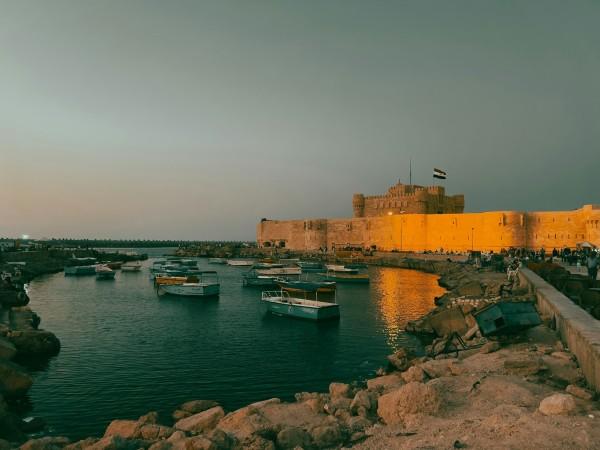
Overview of Alexandria
History & Cultural Influence
Alexandria’s story begins with Alexander the Great, whose vision transformed a modest fishing village into a thriving metropolis. The city swiftly became a beacon of Greek culture and scholarship, with the famed Library of Alexandria serving as a historic information hub. Over the centuries, Alexandria has been a melting pot of cultures, experiencing Roman, Byzantine, and Islamic influences that have shaped its unique character. Today, Alexandria stands as a testament to its rich cultural tapestry. Exploring Alexandria is like stepping back in time, where each corner reveals a new chapter of its storied past. From its ancient ruins to its modern cultural venues, the city offers a compelling journey through history and culture.
Interaction with the Locals
Alexandria, Egypt’s second-largest city, has a population of approximately 6.1 million people. The city is a melting pot of cultures, reflecting its rich historical legacy and modern urban life. Its residents are known for their warmth and hospitality, contributing to the city’s vibrant and diverse atmosphere. Alexandria’s population includes a mix of locals and expatriates, creating a dynamic community that blends traditional Egyptian culture with contemporary influences.
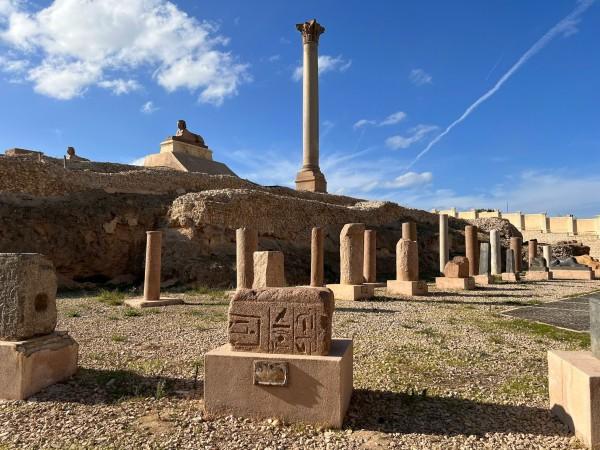
Pompey’s Pillar and the Serapeum - © Malova Yuliya
Top Attractions in Alexandria
Historical Sites in Alexandria
- Citadel of Qaitbay: Built in 1477 AD by Sultan Qaitbay, this fortress stands on the site of the legendary Lighthouse of Alexandria, one of the Seven Wonders of the Ancient World. The Citadel was strategically positioned to protect the city from sea invasions and is now a historical gem offering panoramic views of the Mediterranean Sea and the bustling Alexandria harbor.
- Pompey’s Pillar and the Serapeum: Pompey’s Pillar, a 28-meter-high monolithic column, is one of the largest of its kind in the world and was erected in honor of Emperor Diocletian in the 4th century AD. It is situated among the remains of the Serapeum, a large temple devoted to the deity Serapis that was one of the most important religious sites in ancient Alexandria.
Iconic Landmarks in Alexandria
- Alexandria National Museum: Housed in the 19th-century Palace of the Khedival, the Alexandria National Museum provides a comprehensive overview of Alexandria’s history through its diverse exhibits. The museum houses antiquities from several ages, including Pharaonic sculptures, Greco-Roman relics, and Islamic art. Highlights include the collection of mummies, ancient jewelry, and a detailed model of ancient Alexandria.
- Alexandria Library (Bibliotheca Alexandrina): Inspired by the ancient Library of Alexandria, the Bibliotheca Alexandrina is a modern architectural marvel and a major cultural center. Opened in 2002, it boasts a vast collection of books, manuscripts, and digital resources. The library’s striking design, featuring a tilting disk shape, symbolizes the sun rising over the Mediterranean. Inside, visitors can explore various sections, including the main reading room, specialized libraries, and exhibition halls.
- Montazah Palace and Gardens: Originally built as a summer residence for Egypt’s royal family in the early 20th century, Montazah Palace is set within expansive gardens that offer a serene escape from the city’s hustle and bustle. The palace’s architecture combines Ottoman and Italianate styles, reflecting its royal heritage.
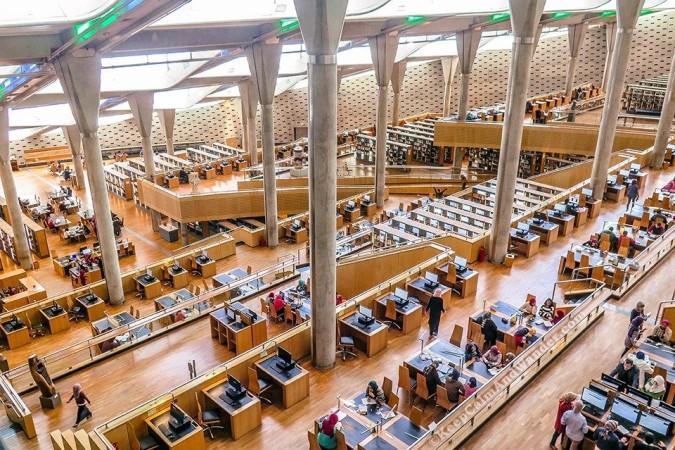
Alexandria Library (Bibliotheca Alexandrina) - © Wikipedia
Must-Try Dishes in Alexandria
- Grilled Fish: Being a coastal city, Alexandria is renowned for its fresh and flavorful seafood. Grilled fish is a local favorite, typically seasoned with a blend of aromatic herbs and spices before being grilled to perfection. Often served with a side of rice or vegetables, this dish captures the essence of the Mediterranean Sea and is a must-try for any seafood lover.
- Shrimp Dishes: Alexandria’s proximity to the sea means that shrimp is always fresh and delicious. Shrimp dishes in Alexandria range from simple grilled shrimp to more elaborate preparations like shrimp in a garlic and lemon sauce. These dishes are often accompanied by a variety of fresh salads and dips, making them a delightful and satisfying option.
- Koshari: Koshari is a delicious Egyptian meal made of rice, lentils, pasta, and chickpeas, topped with a spicy tomato sauce and crispy fried onions. This dish is beloved for its rich flavors and satisfying texture, and it’s commonly enjoyed as a filling meal any time of day.
- Ful Medames: Ful Medames is a typical Egyptian meal consisting of slow-cooked fava beans seasoned with olive oil, garlic, and lemon. Often served with warm pita bread, this dish is a popular choice for breakfast or as a side dish and offers a simple yet flavorful taste of Egyptian cuisine.
- Ta’ameya: Ta’ameya, also known as Egyptian falafel, is made from fava beans and spices, then deep-fried to a crispy perfection. Typically served in a pita bread with fresh vegetables and tahini sauce, Ta’ameya is a delicious and popular street food that’s both satisfying and easy to enjoy on the go.
- Basbousa: For dessert, try Basbousa, a sweet semolina cake soaked in a fragrant sugar syrup and often garnished with almonds or coconut. This delightful treat is a popular choice in Alexandria and throughout Egypt, offering a sweet and satisfying end to any meal.

Basbousa - © Lurpak
Festivals & Local Celebrations
Alexandria International Film Festival
The Alexandria International Film Festival is a premier cultural event celebrating cinema from around the world. Held annually, this festival features a diverse selection of films, including international and Egyptian entries. The event allows filmmakers to present their work and interact with spectators, creating a rich cultural experience for cinema fans.
Montazah Summer Festival
Experience the vibrant Montazah Summer Festival, a highlight of Alexandria’s summer season. This festival takes place in the picturesque Montazah Palace Gardens and offers a variety of cultural performances, including live music, dance, and theatrical shows. The festival’s festive atmosphere and scenic backdrop make it a popular event for both locals and tourists.
Pharaonic Festival
The Pharaonic Festival is a unique cultural event that celebrates Egypt’s ancient heritage. Held at various locations in Alexandria, including the Greco-Roman Museum, the festival features reenactments, traditional music, dance performances, and educational activities related to ancient Egyptian history and culture.
Alexandria Spring Festival
Welcoming the arrival of spring, the Alexandria Spring Festival is a lively event that highlights local arts, crafts, and music. The festival includes exhibitions, workshops, and performances that celebrate the season's beauty and creativity. It’s a wonderful opportunity to experience Alexandria’s artistic spirit and community vibrancy.
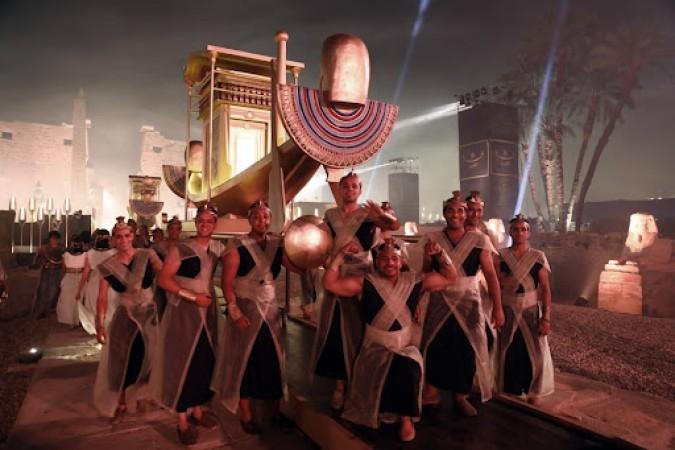
Pharaonic Festival - © News.cn
What to Do in Alexandria
- Citadel of Qaitbay Exploration: Take a guided tour of the Citadel of Qaitbay, a medieval fortification with stunning views of the Mediterranean Sea and Alexandria Harbor. Discover the citadel's history and strategic importance while exploring its ancient ramparts, towers, and the small maritime museum inside.
- Pompey’s Pillar Visit: Explore Pompey's Pillar, a massive column and one of Alexandria's most striking antique sites. A visit to this site also includes the nearby ruins of the Serapeum, offering a glimpse into the city’s rich religious and cultural heritage.
- Relax at Montazah Beach: Enjoy a relaxing day at Montazah Beach, known for its pristine sands and clear blue waters. The beach offers a peaceful retreat with amenities such as sun loungers, umbrellas, and refreshing beachside cafes.
- Alexandria Library Tour: Visit the Bibliotheca Alexandrina, a contemporary architectural masterpiece inspired by the historic Library of Alexandria. Take a tour of its vast collections, including books, manuscripts, and digital resources, and explore its exhibition halls and cultural events.
- Cycling Tours of the Corniche: Join a cycling tour along the Corniche, Alexandria’s picturesque waterfront promenade. This activity offers a great way to enjoy the sea breeze, beautiful views of the Mediterranean, and the city’s lively atmosphere.
- Mediterranean Sunset Cruise: Experience the beauty of Alexandria from the water with a sunset boat cruise. Relax on board as you cruise around the coast, taking in breathtaking views of the city skyline and the Mediterranean Sea at nightfall.
Shopping in Alexandria
- Souk El-Attarine: Souk El-Attarine is a traditional market known for its wide array of spices, herbs, and aromatic oils. This historic market offers a sensory overload with its colorful stalls and fragrant spices, providing a genuine taste of local shopping culture.
- San Stefano Grand Plaza: For a more contemporary shopping experience, head to San Stefano Grand Plaza, a modern mall featuring a range of international brands, dining options, and entertainment facilities. It’s an ideal spot for those looking to enjoy a blend of luxury shopping and leisure activities.
- City Centre Alexandria: City Centre Alexandria is one of the largest shopping malls in the city, offering a diverse selection of stores, from high-end fashion to electronics. It also includes a variety of dining options and entertainment facilities, making it a popular destination for both shopping and relaxation.
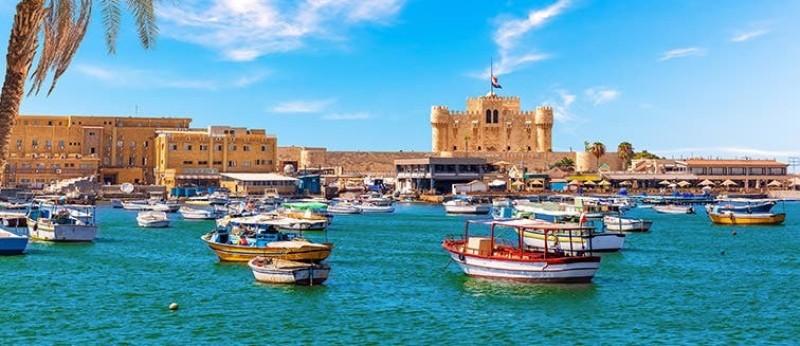
Mediterranean Sunset Cruise - © Altaïr
Weather in Alexandria: Best Time to Visit
Spring in Alexandria
Spring in Alexandria is a prime time for tourism. With temperatures ranging from 65°F to 80°F (18°C to 27°C), the weather is pleasantly warm and ideal for outdoor activities. The city’s parks and historical sites come alive with blooming flowers and clear skies. Spring’s mild weather makes it perfect for exploring Alexandria’s beaches, strolling along the Corniche, and visiting cultural landmarks without the heat of summer.
Summer in Alexandria
Summer in Alexandria brings hot and dry conditions, with temperatures soaring between 85°F and 90°F (29°C to 32°C). The Mediterranean Sea offers a refreshing escape from the heat, making beach activities and water sports particularly popular. Summer is peak tourist season in Alexandria. The city's beaches are bustling with visitors, and many local festivals and outdoor events take place.
Autumn in Alexandria
Autumn offers a gradual transition from the heat of summer to cooler temperatures, ranging from 65°F to 80°F (18°C to 27°C). The weather is generally mild and comfortable, making it an ideal time for exploring Alexandria’s historical sites, gardens, and outdoor markets. Autumn sees a drop in tourist crowds compared to summer, providing a more relaxed experience. It’s a favored season for travelers who prefer fewer crowds while still enjoying pleasant weather.
Winter in Alexandria
Winter in Alexandria is relatively mild compared to other regions, with temperatures averaging between 50°F and 65°F (10°C to 18°C). Rainfall is more frequent, but showers are typically brief. Winter attracts tourists looking for a mild winter getaway. The cooler temperatures are ideal for visiting indoor attractions such as museums and libraries, while the reduced crowds make it a peaceful time to explore the city’s cultural and historical sites.
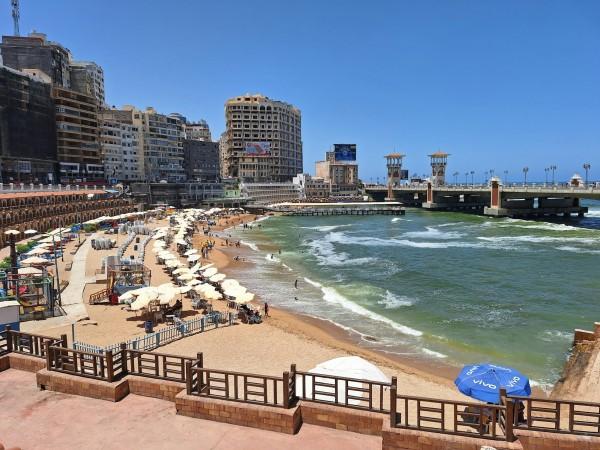
Relax at Montazah Beach - © Mostafa Mahdy
Essential Travel Information
Getting Around Alexandria
- Public Transportation: Alexandria’s public transportation system includes buses and trams that connect key areas of the city. Buses are a cost-effective option, while trams offer a scenic route through the city. Keep in mind that public transit might get congested, especially during peak hours.
- Taxis and Ride-Sharing: Taxis are readily accessible and may be hailed on the street or reserved by phone. Alternatively, ride-sharing apps like Uber and Careem are popular in Alexandria and provide a convenient and reliable way to get around.
- Car Rentals: Renting a car gives you the opportunity to explore the city and its surroundings at your own speed.
- Walking and Bicycling: Many of Alexandria’s attractions are within walking distance of each other. Walking is a great way to explore the city’s historic areas and coastal promenades.
ATM & Banking Services
In Alexandria, banking and financial services are conveniently accessible throughout the city. Numerous ATMs are available in key areas such as commercial districts, shopping centers, and near popular tourist attractions, allowing easy access to cash with international credit and debit cards. For more comprehensive financial needs, various banks provide services including currency exchange, money transfers, and general banking assistance.
Where to Stay in Alexandria
- Luxury Hotels: These luxury hotels provide elegant rooms, exceptional service, and facilities such as fine dining restaurants, spas, and fitness centers. Keep in mind that public transit might get congested, especially during peak hours.
- Mid-Range Hotels: These accommodations offer a good balance between affordability and quality, featuring modern amenities like Wi-Fi, on-site dining, and convenient locations. They are ideal for travelers looking for a comfortable stay without exceeding their budget.
- Budget Lodgings: Travelers on a budget will find numerous affordable lodging options, including guesthouses, hostels, and budget hotels. These options provide basic yet comfortable accommodations and are often situated in accessible locations, allowing for easy exploration of the city.
Articles for you

Explore Yala National Park - Sri Lanka Travel, Asia
Tucked away in Sri Lanka’s southeastern corner, Yala National Park is where wild nature meets deep tradition. Known worldwide for its leopard population, the park is also home to elephants, sloth bears, crocodiles, and hundreds of bird species. Beyond wildlife, Yala opens doors to a cultural landscape dotted with ancient temples, Buddhist ruins, and coastal villages. For travelers seeking more than just a safari, Yala offers a chance to explore eco-tourism, local communities, and sacred heritage sites.
Population: The Yala National Park area doesn’t have a human population.
Economy: The economy around Yala National Park thrives on a blend of eco-tourism, agriculture, and local services. Safari tours, eco-lodges, and cultural experiences drive steady income for nearby towns like Tissamaharama and Kataragama, supporting thousands of families.
Landmarks: Famous for Block I of Yala and wildlife encounters, including elephants, sloth bears, crocodiles, and exotic bird species.

Explore Galle - Sri Lanka Travel, Asia
Nestled on Sri Lanka’s southern coastline, Galle is a vibrant city where history meets the sea. Its cobbled streets, colonial architecture, and serene beaches make it a must-visit destination for travelers seeking a blend of culture, adventure, and relaxation. A UNESCO World Heritage site, Galle captivates visitors with its Dutch Fort, bustling markets, and friendly locals. Whether you’re exploring the ramparts at sunset or savoring fresh seafood by the shore, Galle promises an unforgettable journey into Sri Lanka’s heritage.
Population: Approximately 113,000 in 2023.
Economy: Galle’s economy thrives on tourism, trade, and fisheries. The city’s historic fort, colonial architecture, and coastal charm draw thousands of international visitors each year, making tourism its main economic driver. Fishing remains vital for local livelihoods, supplying fresh seafood across the region.
Landmarks: Famous for the Galle Fort, Dutch Reformed Church & Maritime Museum, and Unawatuna Beach.

Explore Bentota - Sri Lanka Travel, Asia
Nestled along Sri Lanka’s southwestern coast, Bentota is a tropical paradise that blends golden beaches, vibrant culture, and thrilling adventures. Famous for its calm waters, luxury resorts, and scenic river estuary, Bentota has become a top destination for travelers seeking both relaxation and authentic experiences. From serene beach walks at sunrise to adrenaline-pumping water sports, this coastal town offers a perfect balance of leisure and exploration. With its proximity to Colombo and Galle, Bentota is easy to reach, making it an ideal stop for both short escapes and extended holidays.
Population: Approximately 37,000 in 2023.
Economy: Bentota’s economy thrives mainly on tourism, which drives local businesses such as hotels, restaurants, and wellness retreats. The town also benefits from fishing, coconut cultivation, and handicrafts like wood carving and batik textiles. Many residents rely on the growing demand for water sports and Ayurvedic treatments, making tourism the backbone of both income and employment in the area.
Landmarks: Famous for Bentota Beach, Bentota River Safari, and Kande Vihara Temple.

Explore Mirissa - Sri Lanka Travel, Asia
Mirissa is a charming coastal town on Sri Lanka’s southern shoreline. Known for its golden beaches, turquoise waters, and vibrant marine life, it has become a must-visit stop for travelers exploring the island. Many come for whale watching, surfing, and sunset views at Coconut Tree Hill, but Mirissa offers much more than postcard beauty. The fishing boats you see anchored by the bay carry generations of stories. Local traditions, delicious cuisine, and a laid-back rhythm of life shape every visitor’s experience.
Population: Approximately 4,700 in 2023.
Economy: Mirissa’s economy is largely shaped by its coastal location. Fishing has long been the backbone of local livelihoods, with generations relying on the Indian Ocean for income. In recent decades, tourism has become the main driver of growth, thanks to whale watching, surfing, and beachside hospitality.
Landmarks: Famous for Mirissa Beach, Coconut Tree Hill, and Parrot Rock Bridge.

Explore Nuwara Eliya - Sri Lanka Travel, Asia
Tucked away in the Central Highlands of Sri Lanka, Nuwara Eliya is often called “Little England”. With its rolling tea plantations, cool misty mornings, and colonial charm, this mountain town feels like a step into another world. Travelers come here to breathe fresh air, walk through flower gardens, sip the finest Ceylon Tea, and enjoy a pace of life far from the island’s busy cities. Whether you’re drawn by scenic landscapes, heritage architecture, or the warmth of its people, Nuwara Eliya is a destination that blends nature, culture, and history in perfect harmony.
Population: Approximately 781,000 in 2023.
Economy: Nuwara Eliya’s economy thrives mainly on tea production, as it sits in the heart of Sri Lanka’s central highlands, famous worldwide for Ceylon Tea. The city also benefits from a growing tourism industry, attracting visitors with its colonial charm, cool climate, and scenic landscapes.
Landmarks: Famous for Gregory Lake, Hakgala Botanical Garden, and Victoria Park.

Explore Sukau - Malaysia Travel, Asia
Nestled on the banks of the Kinabatangan River in Sabah, Malaysian Borneo, Sukau is a destination where wildlife, culture, and conservation come together. Known as one of Asia’s top spots for river safaris and eco-tourism, this quiet village offers a front-row seat to encounters with Bornean orangutans, pygmy elephants, proboscis monkeys, and exotic birdlife.
Population: Approximately 1,400 in 2019.
Economy: Sukau’s economy is shaped by its riverine location and natural resources. Traditionally, the Orang Sungai community relied on fishing, small-scale farming, and forest gathering for their livelihood. Today, the village has shifted toward eco-tourism, with river cruises, jungle trekking, and homestays providing income.
Landmarks: Famous for the Kinabatangan River cruises, Gomantong Caves, and Ox-bow lakes and wetlands.
